Archives
-
Comparative evaluation of future collider options: Future Colliders Comparative Evaluation Working Group
Vol. 11 (2025)Corresponding authors: G. Arduini and N. Mounet
In anticipation of the completion of the High-Luminosity Large Hadron Collider (HL-LHC) programme by the end of 2041, CERN is preparing to launch a new major facility in the mid-2040s. According to the 2020 update of the European Strategy for Particle Physics (ESPP), the highest-priority next collider is an electron–positron Higgs factory, followed in the longer term by a hadron–hadron collider at the highest achievable energy.
The CERN directorate established a Future Colliders Comparative Evaluation working group in June 2023. This group brings together project leaders and domain experts to conduct a consistent evaluation of the Future Circular Collider (FCC) and alternative scenarios based on shared assumptions and standardized criteria.
This report presents a comparative evaluation of proposed future collider projects submitted as input for the Update of the European Strategy for Particle Physics. These proposals are compared considering main performance parameters, environmental impact and sustainability, technical maturity, cost of construction and operation, required human resources, and realistic implementation timelines.
An overview of the international collider projects within a similar timeframe, notably the CEPC in China and the ILC in Japan is also presented, as well as a short review of the status and prospects of new accelerator techniques.
-
70 years of particle physics
Vol. 10 (2025)Daniel Treille and Felicitas Pauss
This document presents a selection of topics in Particle Physics, from the early periods of its existence until today.
It is aimed at specialists in the field, hoping to inform the young ones about the past and recalls important moments to the seniors who want to refresh their memory.
Many highlights of our field are described, but less bright periods, doubts, and temporarily wrong paths are not kept hidden, and problems are presented as they appeared at the time.
An attempt was made to find the right balance between technology and physics, and to acknowledge in a fair way the important contributions of actors with very different profiles.
The document includes various comments and points of view, but always only drawn from published material.
The document proposes many references, which are mostly publications, entries in the INSPIRE data base or free access books, e.g., the book “Technology Meets Research” . However, it also contains interesting figures that have been taken from public lectures given by experts at conferences, workshops and in physics schools, with the relevant sources cited. As far as possible, the reference gives direct access to the relevant material.
Furthermore, this document describes the most up-to-date results and presents the major questions left open. From these, one can deduce possible guidelines for the future, but considerations of strategy and discussions on what may come next in terms of machines and programmes are not part of this document.
The fundamentals of the different subjects are usually only referenced to, but some topics are explained by including short introductory texts.
Besides the Particle Physics Standard Model (PPSM) another “Standard Model” exists, including what we know about our universe, its content and possibly its history. This document also deals with the relations between both domains.
The work started as a review of 60 years of Particle Physics at the Société Française de Physique (SFP), and initially emphasised the French contributions to these fields. This aspect has been largely removed, and the document attempts to cover contributions from key players around the world, although activities involving CERN programs still occupy a large part. This is motivated by CERN’s 70th birthday, celebrated in 2024. -
Physics Briefing Book: Input for the 2026 update of the European Strategy for Particle Physics
Vol. 8 (2025)Editors: Roger Forty, Karl Jakobs, Hugh Montgomery, Mike Seidel, and Paris Sphicas
The CERN Council established the European Strategy Group (ESG), which is responsible for submitting final recommendations to the Council for approval in early 2026. The Strategy Secretariat is in charge of organising the full process. In deriving the recommendations, the European Strategy for Particle Physics update should take into account the input of the particle physics community, progress in implementation of the 2020 Strategy update, and the accomplishments in recent years. These should include results from the LHC and other experiments or facilities worldwide, progress in the construction of the High-Luminosity LHC and physics expectations from its operation, the FCC Feasibility Study, and recent technological developments in accelerators, detectors, and computing. The Physics Preparatory Group (PPG) is to distill the community’s scientific input and the scientific discussion at the Open Symposium into the current “Physics Briefing Book”. This book is provided to the ESG as the foundation for their consideration during their five-day-long session for drafting the recommendations. The Physics Briefing Book is also shared with the particle physics community for their final input into the process. For the evaluation of the physics performance of the proposed colliders and experiments in other areas, benchmark processes and measurements have been defined by nine PPG working groups. The focus in this book is on the presentation and discussion of the performance against these benchmarks. The book does not aim to give a complete and comprehensive overview on the different physics and technology areas.
-
The DEFT facility: An accelerator for very-high-energy electron FLASH radiotherapy—Technical design report
Vol. 7 (2025)Maria Elena Angoletta et al.
Corresponding editors: Alexej Grudiev and Andrea Latina
The design of an accelerator facility capable of delivering FLASH radiotherapy to large, deep-seated tumours is presented. The facility, called DEFT (Deep Electron Flash Therapy), produces 140 MeV electrons so is capable of treating tumours located at depths up to 25 cm. It is capable of delivering sufficient electron intensity to treat tumours up to 20 cm in diameter, in less than 0.1 s with doses up to 20 to 30 Gy. The full facility, including electron source, accelerator and beam delivery system are described along with extensive performance simulations.
-

The hadron collider FCC-hh: Extended conceptual design report
Vol. 6 (2025)Editor: Daniel Schulte, CERN
This document provides a detailed account of several studies regarding the design of the FCC-hh hadron collider that have been performed in the time period between 2019 and 2021. They extend and complement the studies reported in the conceptual design report submitted to the 2019 Update of the European Strategy for Particle Physics.
-

ECFA Higgs, electroweak, and top factory study
Vol. 5 (2025)Editors: Aidan Robson and Christos Leonidopoulos
The ECFA Higgs, electroweak, and top Factory Study ran between 2021 and 2025 as a broad effort across the experimental and theoretical particle physics communities, bringing together participants from many different proposed future collider projects. Activities across three main working groups advanced the joint development of tools and analysis techniques, fostered new considerations of detector design and optimisation, and led to a new set of studies resulting in improved projected sensitivities across a wide physics programme. This report demonstrates the significant expansion in the state-of-the-art understanding of the physics potential of future e+e– Higgs, electroweak, and top factories, and has been submitted as input to the 2025 European Strategy for Particle Physics Update.
-
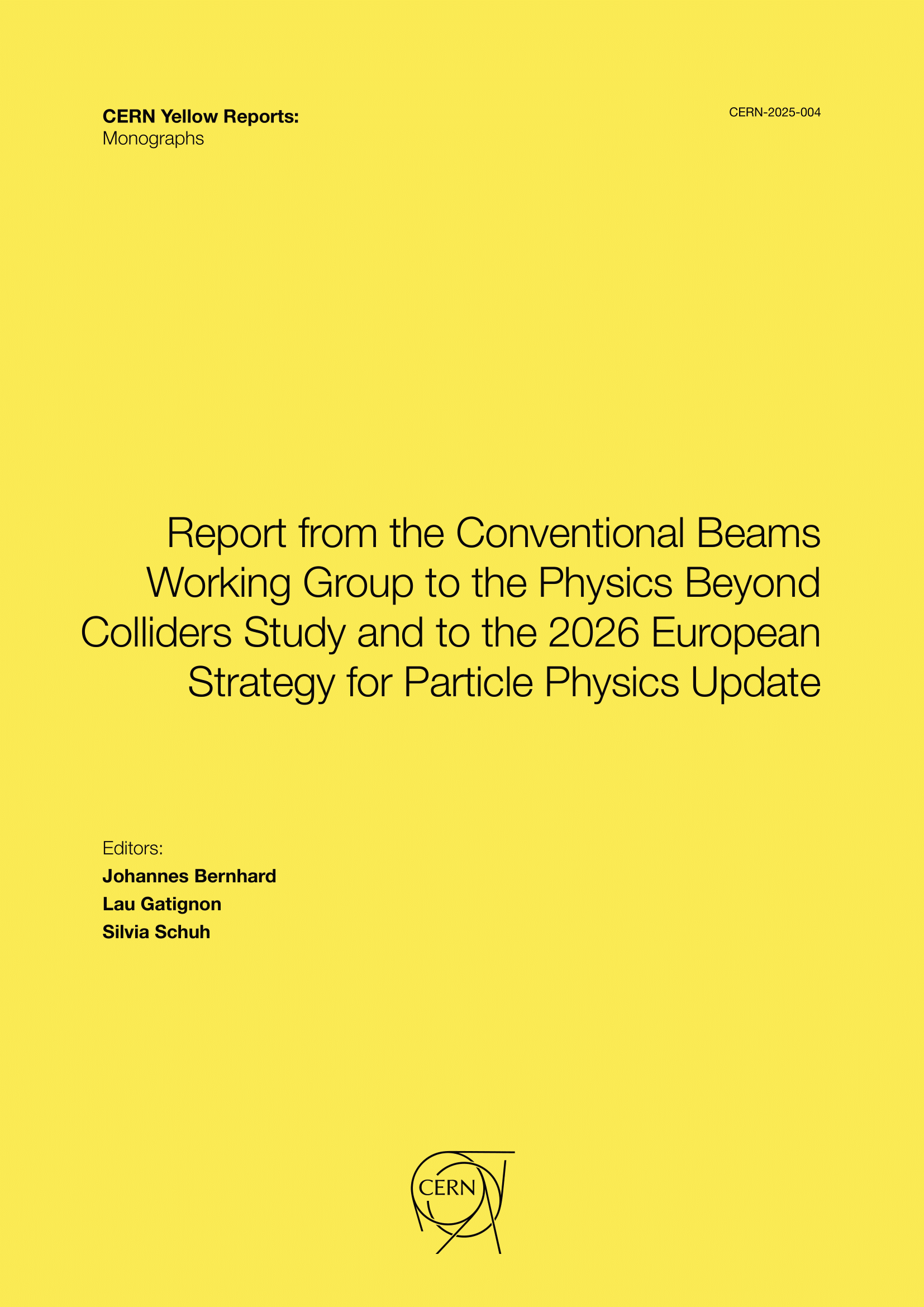
Report from the Conventional Beams Working Group to the Physics Beyond Colliders Study and to the 2026 European Strategy for Particle Physics Update
Vol. 4 (2025)Editors: Johannes Bernhard, Lau Gatignon, and Silvia Schuh
This document reports the work and results of the Conventional Beams Working Group, which focuses on studies of the beam-related and technical requirements and requests from proposals submitted to the Physics Beyond Colliders Study (PBC) for the North Area at the CERN SPS and the East Area at the CERN PS accelerators. Previous CBWG reports have been published in 2018 and 2022, providing inputs to the European Strategy for Particle Physics (ESPP) discussions that took place in those years. This new document provides updated and supplementary material relevant for the 2025–2026 ESPP Update, including detailed results regarding the HIKE, SHADOWS, DICE/NA60+, ENUBET, NuTag, and SBN projects. Please note that BDF/SHiP was studied in an independent PBC Working Group. Since its inception, the working group has presented results on feasibility, requirements, compatibility between proposals, and, where possible, cost estimates at all PBC Annual Workshops and group meetings. Following the renewed mandate of the PBC Study in 2021, the Conventional Beams Working Group continued its studies for previously received proposals, as well as for new initiatives, including ENUBET, NuTag, a potential Short-Baseline tagged neutrino beam (SBN), SHADOWS, and HIKE. Work relevant to these studies has progressed since the Annual PBC Workshop in 2019, which this document summarises. This edition also includes information on installation work already carried out for some proposals and presents initial studies for the more recent ones.
The physics interest, sensitivity reach, and worldwide competitiveness of the proposals are discussed in the PBC working groups for Beyond Standard Model (BSM) physics and Quantum ChromoDynamics (QCD), as well as in the newly established working group on Feebly Interacting Particles (FIPs). These physics-focused working groups collaborate in close synergy with the Conventional Beams Working Group.
-
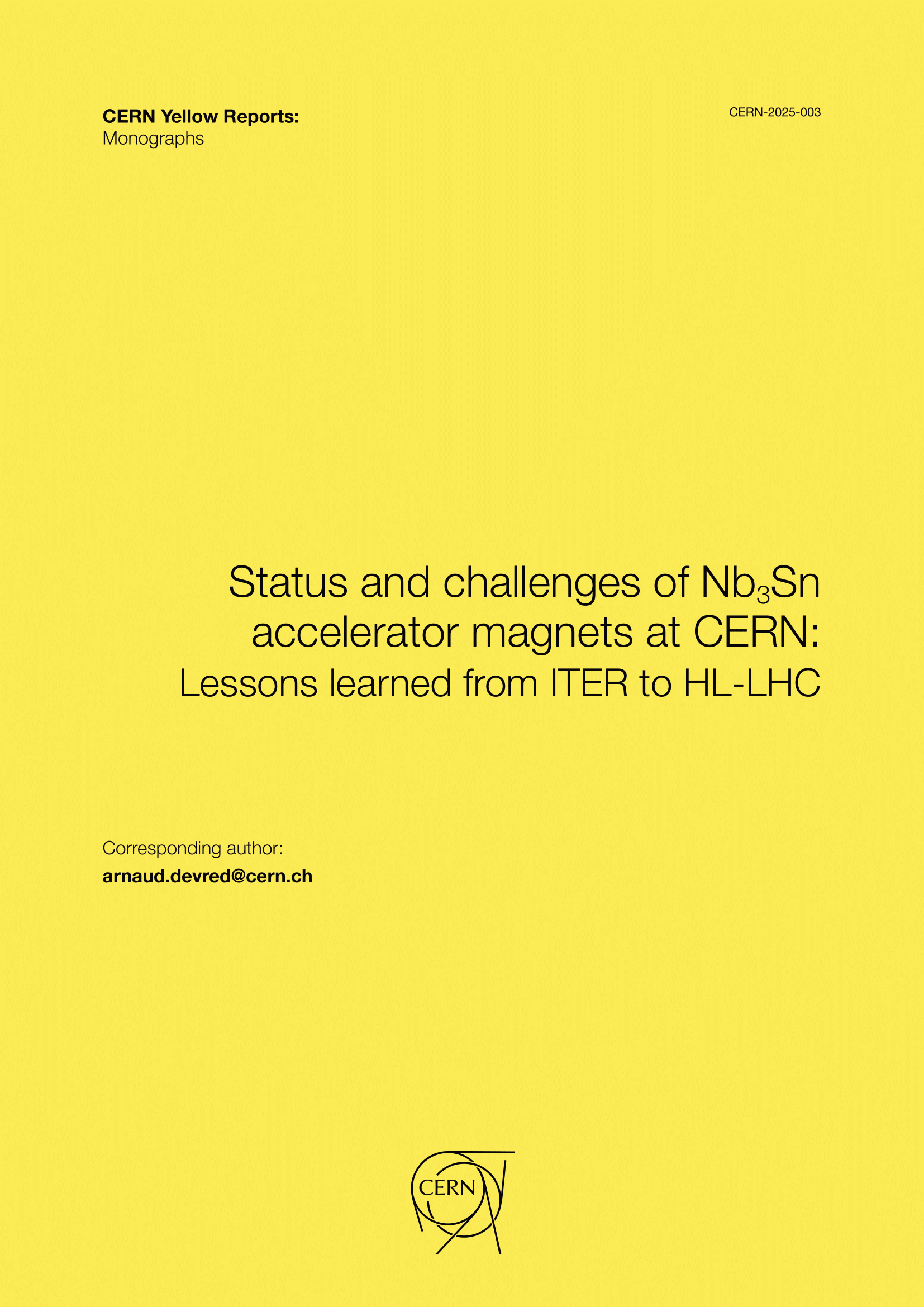
Status and challenges of Nb3Sn accelerator magnets at CERN: Lessons learned from ITER to HL-LHC
Vol. 3 (2025)Corresponding author: Arnaud Devred.
The High-Luminosity Large Hadron Collider (HL-LHC) project at CERN has offered the opportunity to promote and develop various types of enabling accelerator technologies, such as MgB2 superconducting links for cold powering and Nb3Sn accelerator magnets for the interaction regions where the two high-luminosity experimental areas of the machine are located.A prototype superconducting link system has been successfully tested in the second quarter of 2024 and series production is now ongoing. The Nb3Sn magnet development has encountered some difficulties characterized by performance limitation or degradation, which have now been overcome. We report on the status and challenges of HL-LHC Nb3Sn accelerator magnets at CERN, with a primary focus on the root-cause analyses and recovery actions implemented for the 11 T dipole magnet program and for the final-focusing quadrupole magnet program. The symptoms have similarities with those encountered over a decade ago on the Nb3Sn Cable-in-Conduit conductors for the magnets of the International Thermonuclear Experimental Reactor (ITER) and the methodology to address them was inspired from that developed to resolve the ITER crisis. Thanks to the successful efforts of ITER and HL- LHC, Nb3Sn has been demonstrated to be a viable technology for fusion and accelerator magnet applications and is now reaching maturity.
-
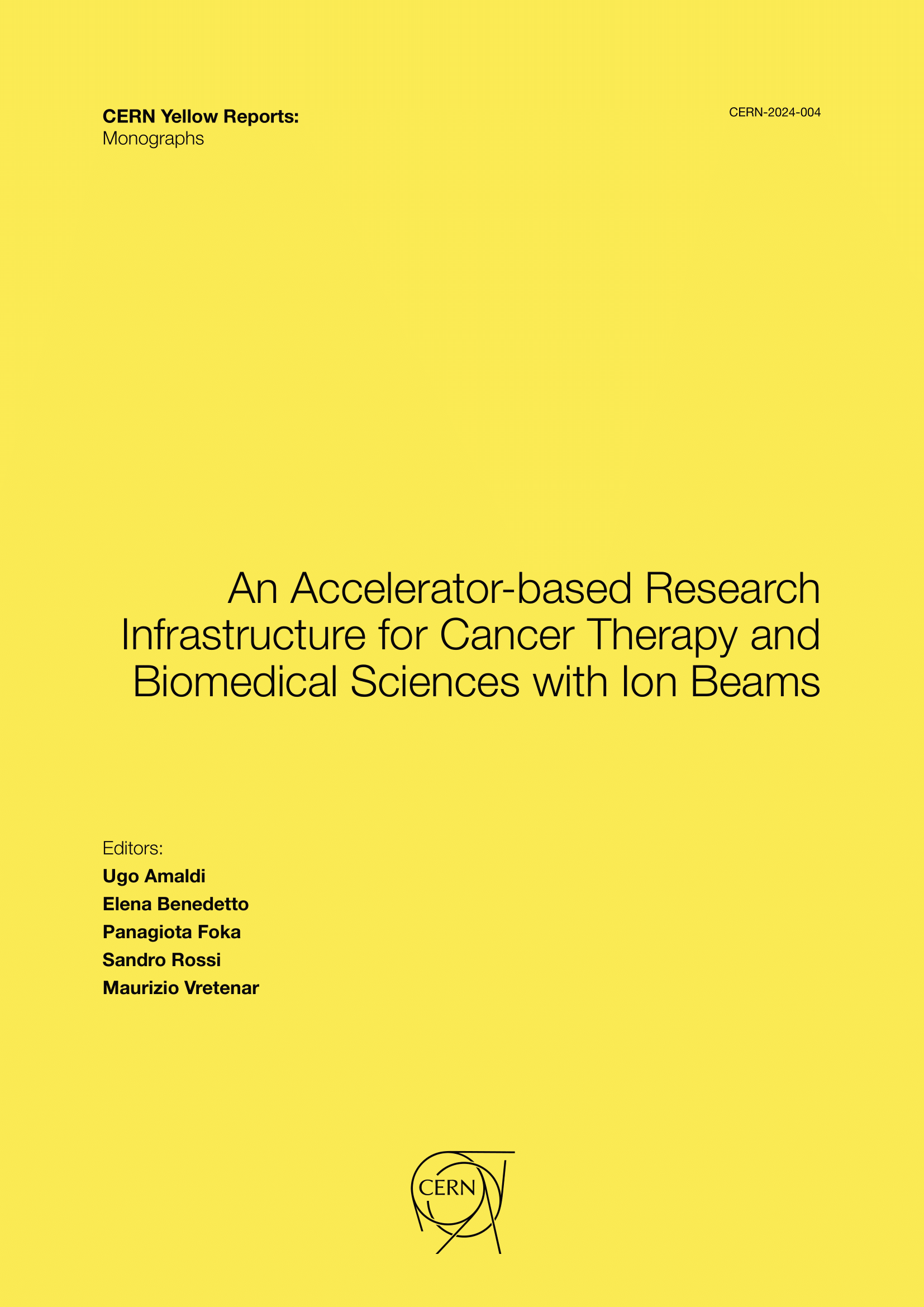
An Accelerator-based Research Infrastructure for Cancer Therapy and Biomedical Sciences with Ion Beams
Vol. 4 (2024)Editors: Ugo Amaldi, Elena Benedetto, Panagiota Foka, Sandro Rossi, and Maurizio Vretenar
This report describes the general framework, research goals, preliminary technical design, and resources required for a novel accelerator-based research infrastructure for cancer therapy and biomedical sciences with ion beams. The information presented is the result of five years of research and design activities conducted by a wide multinational collaboration to address the needs of the South East European International Institute for Sustainable Technologies (SEEIIST), an initiative aiming at the construction in South East Europe of a facility devoted to cancer research and therapy with ion beams. The new design combines the experience of the European ion therapy centres and integrates innovative features that will push the performance much beyond the present state of the art for European carbon ion facilities.
Keywords: Medical physics; Hadron therapy; FLASH; Particle accelerators; Synchrotrons.
-

Interim report for the International Muon Collider Collaboration
Vol. 2 (2024)This document summarises the International Muon Collider Collaboration (IMCC) progress and status of the Muon Collider R&D programme.
This version of the document corresponds to the revised version, dated 28 Jan 2025, posted to the arXiv with some minor modifications to the author list.
-

Conceptual design of an experiment at the FCC-hh, a future 100 TeV hadron collider
Vol. 2 (2022)Eds. M. Mangano and W. Riegler
This report summarises the study of a general purpose detector for the FCC-hh, a 100 TeV hadron collider with peak luminosity of 3 ⋅ 1035 cm-2s-1. A pileup of 1000 pp collisions per bunch-crossing, highly boosted objects as well as radiation levels up to 1018 hadrons/cm2 are just three of the challenges that such a collider poses. The general specifications for such a detector in terms of resolution, granularity, acceptance and radiation tolerance are discussed. A specific detector layout is proposed and its performance is simulated, discussed and parameterized. This parameterization is then used to evaluate the performance for key benchmark physics topics, such as the precision measurement of the Higgs boson couplings and the discovery reach for several frameworks beyond the Standard Model.
-

European Strategy for Particle Physics - Accelerator R&D Roadmap
Vol. 1 (2022)European Strategy Update | Laboratory Directors Group
Editor: Nicolas Mounet
The 2020 update of the European Strategy for Particle Physics emphasised the importance of an intensified and well-coordinated programme of accelerator R&D, supporting the design and delivery of future particle accelerators in a timely, affordable and sustainable way. This report sets out a roadmap for European accelerator R&D for the next five to ten years, covering five topical areas identified in the Strategy update. The R&D objectives include: improvement of the performance and cost-performance of magnet and radio frequency acceleration systems; investigations of the potential of laser/plasma acceleration and energy-recovery linac techniques; and development of new concepts for muon beams and muon colliders. The goal of the roadmap is to document the collective view of the field on the next steps for the R&D programme, and to provide the evidence base to support subsequent decisions on prioritisation, resourcing and implementation.
-
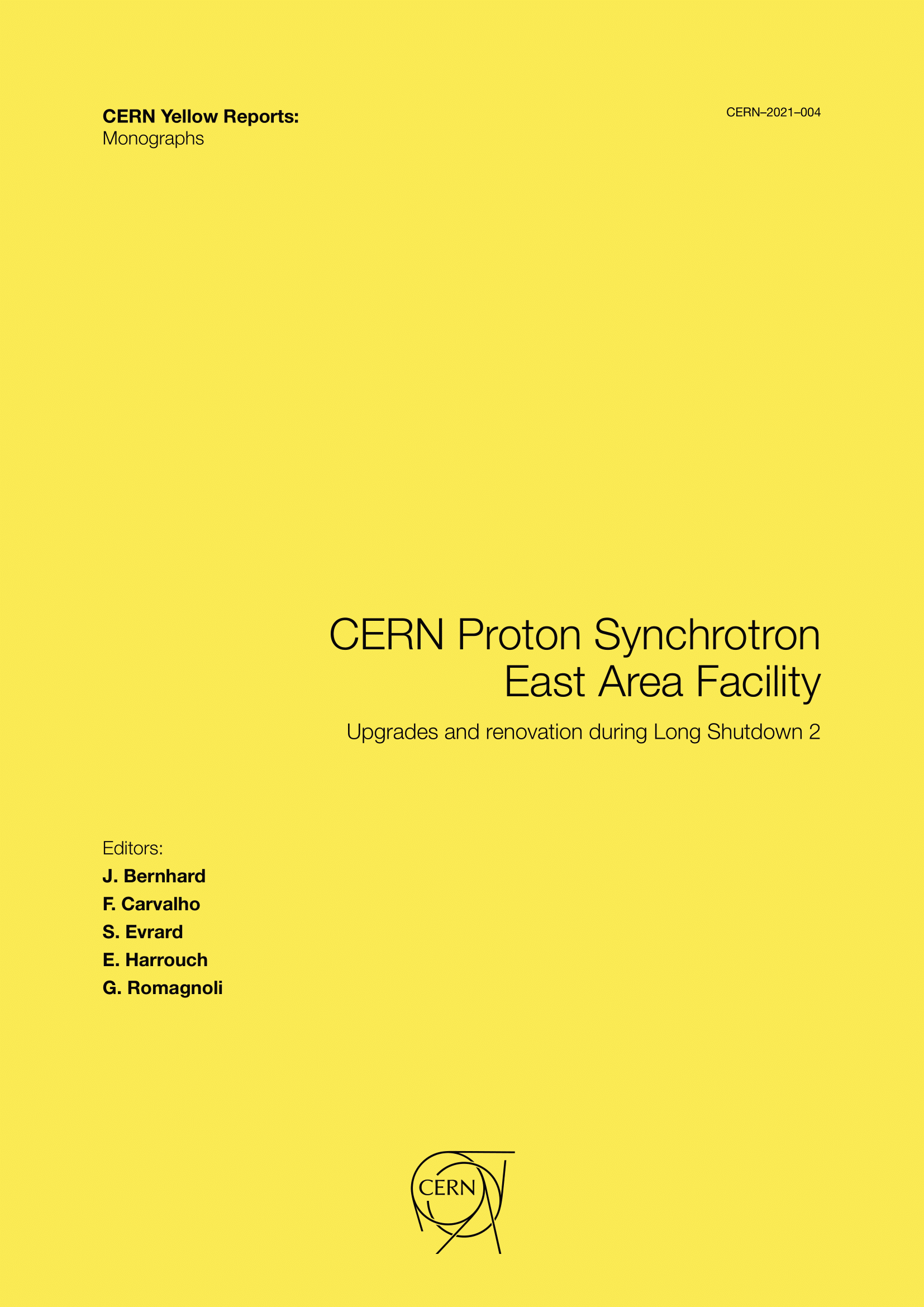
CERN Proton Synchrotron East Area Facility: Upgrades and renovation during Long Shutdown 2
Vol. 4 (2021)Editors: Johannes Bernhard, Filipa Carvalho, Sébastien Evrard, Erwan Harrouch and Giulia Romagnoli.
In this document, we present the upgrade of the East Experimental Area facility which took place during the Long Shutdown 2 (2019–2021). This document covers the renovation of the East Hall beamlines and infrastructure according to a new layout with the goal of improving the magnet and radiation situation in general. The performance of the new beamlines will be optimized in terms of maximum momentum and choice of particle type. Thanks to a cycled powering mode of the magnets instead of a steady state one, considerable energy savings will be possible. This report summarizes the various detailed studies completed from 2016 to 2019.
-
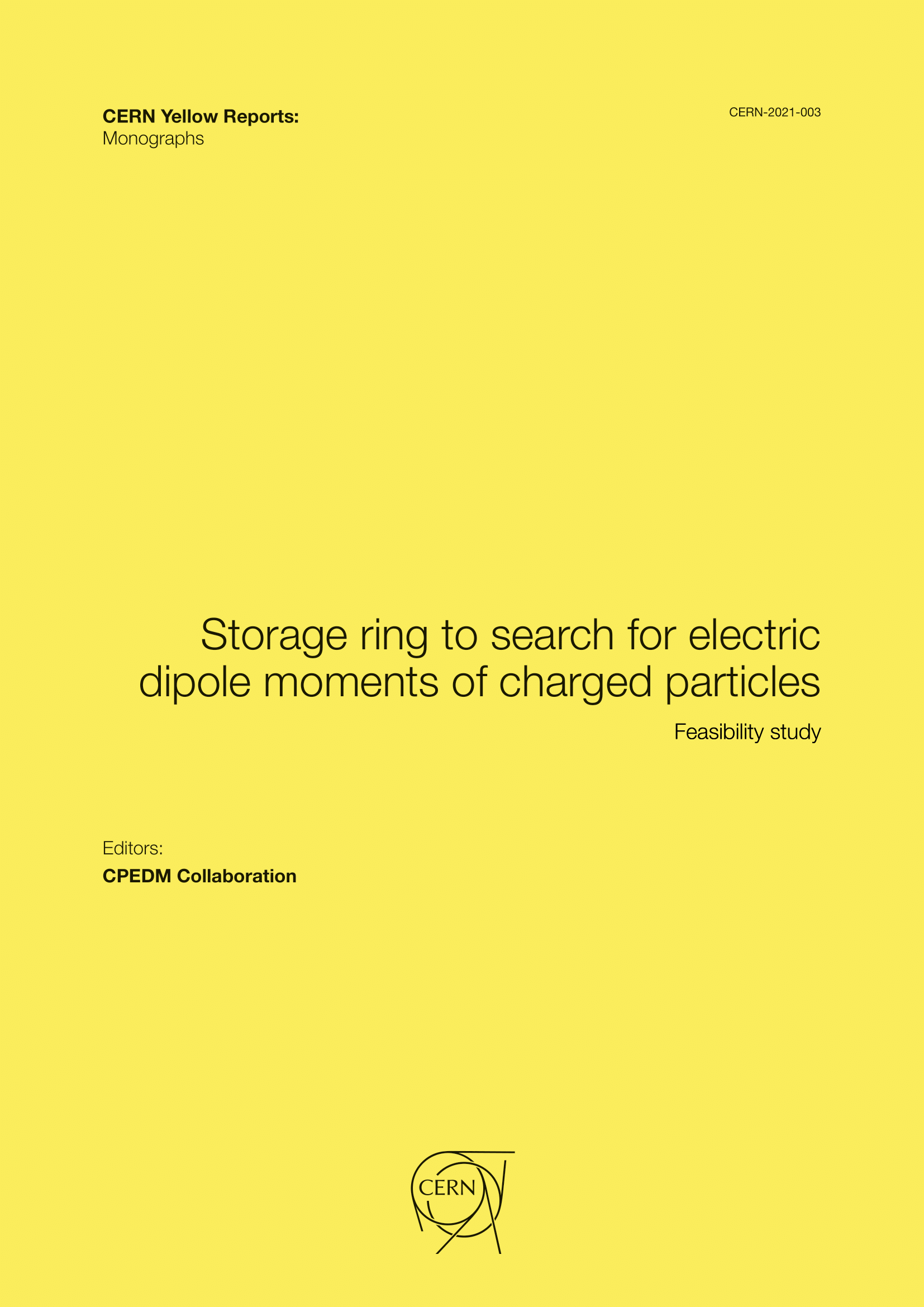
Storage ring to search for electric dipole moments of charged particles: Feasibility study
Vol. 3 (2021)CPEDM Collaboration
The proposed method exploits charged particles confined as a storage ring beam (proton, deuteron, possibly 3He) to search for an intrinsic electric dipole moment (EDM) aligned along the particle spin axis. Statistical sensitivities could approach 10−29e cm. The challenge will be to reduce systematic errors to similar levels. The ring will be adjusted to preserve the spin polarization, initially parallel to the particle velocity, for times in excess of 15 min. Large radial electric fields, acting through the EDM, will rotate the polarization from the longitudinal to the vertical direction. The slow increase in the vertical polarization component, detected through scattering from a target, signals the EDM.
The project strategy is outlined. A stepwise plan is foreseen, starting with ongoing COSY activities that demonstrate technical feasibility. Achievements to date include reduced polarization measurement errors, long horizontal plane polarization lifetimes, and control of the polarization direction through feedback from scattering measurements. The project continues with a proof-of-capability measurement (precursor experiment; first direct deuteron EDM measurement), an intermediate prototype ring (proof-of-principle; demonstrator for key technologies), and finally a high-precision electric-field storage ring.
-
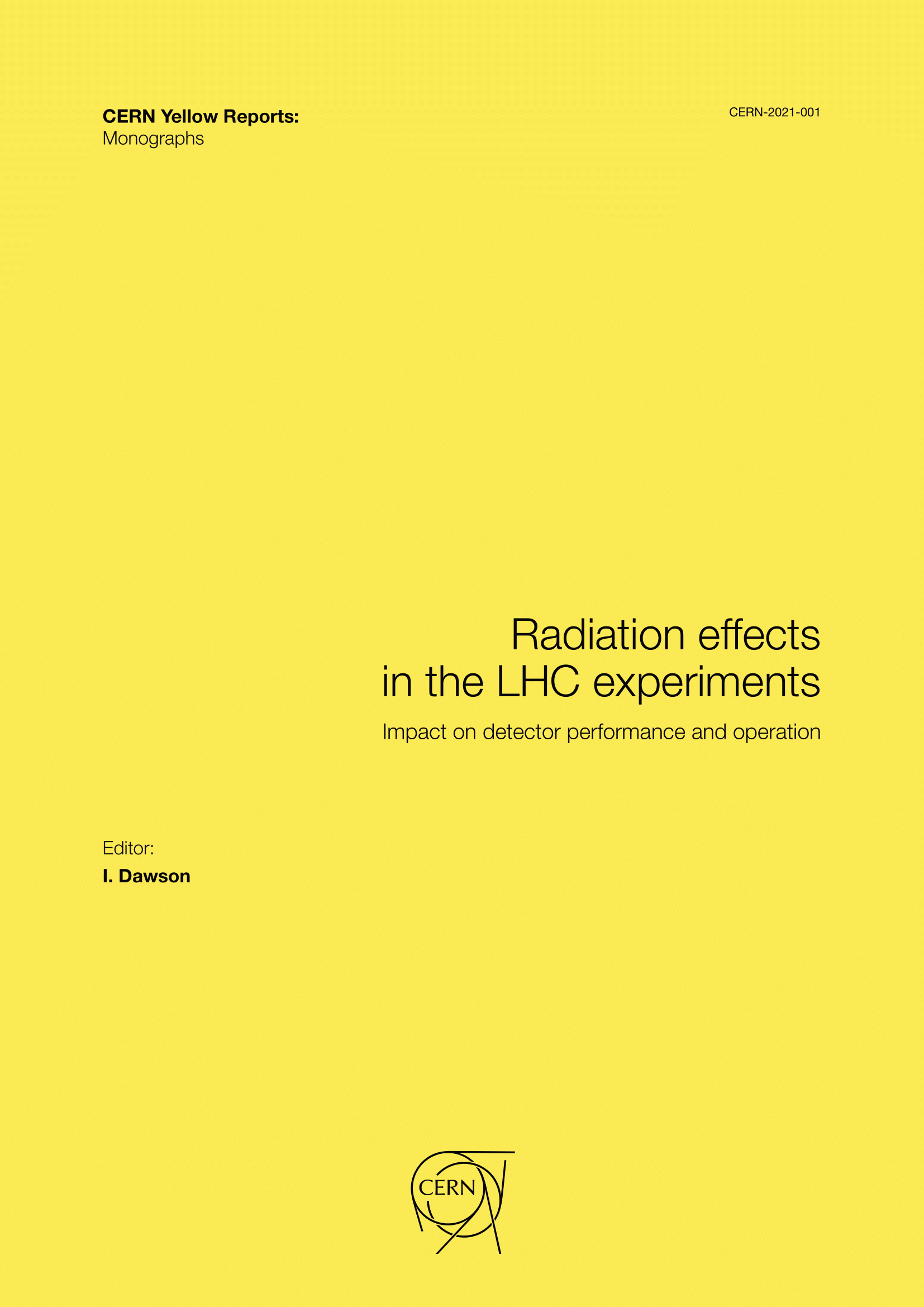
Radiation effects in the LHC experiments: Impact on detector performance and operation
Vol. 1 (2021)Editor: I. Dawson
This report documents the knowledge and experiences gained by the LHC experiments in running detector systems in radiation environments during 2010–2018, with a focus on the inner detector systems. During this time, the LHC machine has delivered a large fraction of the design luminosity to the experiments and the deleterious effects of radiation on detector operation are being observed and measured. It is timely to review the findings from across the experiments.
Questions we aim to answer include:- Are the detector systems operating and performing as expected?
- How reliable are the radiation damage models and predictions?
- How accurate are the Monte Carlo simulation codes?
- Have there been unexpected effects?
- What mitigation strategies have been developed?
A major goal of this report is to provide a reference for future upgrades and for future collider studies, summarizing the experiences and challenges in designing complex detector systems for operation in harsh radiation environments.
-

High-Luminosity Large Hadron Collider (HL-LHC): Technical design report
Vol. 10 (2020)Editors: I. Béjar Alonso, O. Brüning, P. Fessia, M. Lamont, L. Rossi, L. Tavian, M. Zerlauth
The Large Hadron Collider (LHC) is one of the largest scientific instruments ever built. Since opening up a new energy frontier for exploration in 2010, it has gathered a global user community of about 9000 scientists working in fundamental particle physics and the physics of hadronic matter at extreme temperature and density. To sustain and extend its discovery potential, the LHC will need a major upgrade in the 2020s. This will increase its instantaneous luminosity (rate of collisions) by a factor of five beyond the original design value and the integrated luminosity (total number of collisions) by a factor ten. The LHC is already a highly complex and exquisitely optimised machine so this upgrade must be carefully conceived and will require new infrastructures (underground and on surface) and over a decade to implement. The new configuration, known as High Luminosity LHC (HL-LHC), relies on a number of key innovations that push accelerator technology beyond its present limits. Among these are cutting-edge 11–12 Tesla superconducting magnets, compact superconducting cavities for beam rotation with ultra-precise phase control, new technology and physical processes for beam collimation and 100 metre-long high-power superconducting links with negligible energy dissipation, all of which required several years of dedicated R&D effort on a global international level.The present document describes the technologies and components that will be used to realise the project and is intended to serve as the basis for the detailed engineering design of the HL-LHC.
ISBN 978-92-9083-586-8 (paperback), ISBN 978-92-9083-587-5 (PDF).
-

A primary electron beam facility at CERN—eSPS: Conceptual design report
Vol. 8 (2020)Editors: Torsten Åkesson and Steinar Stapnes
The design of a primary electron beam facility at CERN is described. The study has been carried out within the framework of the wider Physics Beyond Colliders study. It re-enables the Super Proton Synchrotron (SPS) as an electron accelerator, and leverages the development invested in Compact Linear Collider (CLIC) technology for its injector and as an accelerator research and development infrastructure. The facility would be relevant for several of the key priorities in the 2020 update of the European Strategy for Particle Physics, such as an electron-positron Higgs factory, accelerator R&D, dark sector physics, and neutrino physics. In addition, it could serve experiments in nuclear physics. The electron beam delivered by this facility would provide access to light dark matter production significantly beyond the targets predicted by a thermal dark matter origin, and for natures of dark matter particles that are not accessible by direct detection experiments. It would also enable electro-nuclear measurements crucial for precise modelling the energy dependence of neutrino-nucleus interactions, which is needed to precisely measure neutrino oscillations as a function of energy. The implementation of the facility is the natural next step in the development of X-band high-gradient acceleration technology, a key technology for compact and cost-effective electron/positron linacs. It would also become the only facility with multi-GeV drive bunches and truly independent electron witness bunches for plasma wakefield acceleration. A second phase capable to deliver positron witness bunches would make it a complete facility for plasma wakefield collider studies.
The facility would be used for the development and studies of a large number of components and phenomena for a future electron-positron Higgs and electroweak factory as the first stage of a next circular collider at CERN, and its cavities in the SPS would be the same type as foreseen for such a future collider. The operation of the SPS with electrons would train a new generation of CERN staff on circular electron accelerators. The facility could start operation in about five years, and would operate in parallel and without interference with Run 4 of the LHC. -

Linac4 design report
Vol. 6 (2020)Editor: Maurizio Vretenar
Linear accelerator 4 (Linac4) is designed to accelerate negative hydrogen ions for injection into the Proton Synchrotron Booster (PSB). It will become the source of proton beams for the Large Hadron Collider (LHC) after the long shutdown in 2019–2020. Linac4 will accelerate H– ions, consisting of a hydrogen atom with an additional electron, to 160 MeV energy and then inject them into the PSB, which is part of the LHC injection chain. The new accelerator comprises an ion source and four types of accelerating structures. The particles are accelerated first to 3 MeV energy by a Radio-Frequency Quadrupole (RFQ), then to 50 MeV by three Drift Tube Linacs (DTL) tanks, then to 100 MeV by seven Cell-Coupled Drift Tube Linac (CCDTL) modules, and finally to 160 MeV by twelve Pi-Mode Structures (PIMS). A chopper line placed between the RFQ and the first DTL tank modulates the linac beam at the PSB injection frequency. Linac4 includes transfer and measurement lines up to the PSB injection, where the ions are stripped of their two electrons to leave only protons. Linac4 is 76 metres long and located 12 metres below ground. The first low-energy beams were produced in 2013 and after the commissioning of all accelerating structures the milestone energy of 160 MeV was reached in 2016. Linac4 will be connected to the PSB during the long shutdown of 2019–20, after which it will replace the 50 MeV Linac2 as source of protons for the LHC. The Linac4 is a key element in the project to increase the luminosity of the LHC during the next decade.
-

LHC fixed target experiments: Report from the LHC Fixed Target Working Group of the CERN Physics Beyond Colliders Forum
Vol. 4 (2020)Corresponding editor: Stefano.Redaelli@cern.ch
Several fixed-target experiments at the LHC are being proposed and actively studied. Splitting of beam halo from the core by means of a bent crystal combined with a second bent crystal after the target has been suggested in order to study magnetic and electric dipole moments of short-lived particles. A similar scheme without the second crystal or other schemes with more conventional solid or gas targets have been proposed to study hadronic matter and the quark-gluon plasma, as well as to provide inputs to cosmic ray physics. Most notably, an upgrade of the existing and already productive LHCb gas target (SMOG), which would make use of a storage cell, has been proposed, designed, and extensively reviewed. The implementation in LHCb of a polarised gas target, based on the storage cell technique, was also discussed, motivated by the nucleon-spin study. The status of these proposals, their technical feasibility and impacts on the LHC machine have been studied in the LHC Fixed Target Working Group of the Physics Beyond Collider forum at CERN. The status and outcome of these studies are presented here.
-

Theory for the FCC-ee: Report on the 11th FCC-ee Workshop, Theory and Experiments, CERN, Geneva, 8–11 January 2019
Vol. 3 (2020)Eds. A. Blondel, J. Gluza, S. Jadach, P. Janot and T. Riemann
The Future Circular Collider (FCC) at CERN, a proposed 100 km circular facility with several colliders in succession, culminates in a 100 TeV proton–proton collider. It offers a vast new domain of exploration in particle physics, with orders-of-magnitude advances in terms of precision, sensitivity, and energy. The implementation plan published in 2018 foresees, as a first step, an electroweak factory electron–positron collider. This high-luminosity facility, operating at centre-of-mass energies between 90 and 365 GeV, will study the heavy particles of the Standard Model (SM), Z, W, and Higgs bosons, and top quarks with unprecedented accuracy. The physics programme offers great discovery potential: (i) through precision measurements, (ii) through sensitive searches for symmetry violations, forbidden, or extremely rare decays, and (iii) through the search for direct observation of new particles with extremely small couplings. The electroweak factory e+e- collider constitutes a real challenge to the theory and to precision calculations, triggering the need for the development of new mathematical methods and software tools. A first workshop in 2018 focused on the first FCC-ee stage, the Tera-Z, and confronted the theoretical status of precision Standard Model calculations on the Z boson resonance to the experimental demands. The second workshop, in January 2019, extended the scope to the next stages, with the production of W bosons (FCC-ee-W), the Higgs boson (FCC-ee-H), and top quarks (FCC-ee-tt). In particular, the theoretical precision in the determination of the crucial input parameters, αQED, αQCD, MW, and mt, at the level of FCC-ee requirements was thoroughly discussed. The requirements on Standard Model theory calculations were spelt out, so as to meet the demanding accuracy of the FCC-ee experimental potential. The discussion of innovative methods and tools for multiloop calculations was deepened. Furthermore, phenomenological analyses beyond the Standard Model were discussed, including effective theory approaches. The reports of 2018 and 2019 serve as white papers of the workshop results and subsequent developments.
-

SPS Beam Dump Facility: Comprehensive Design Study
Vol. 2 (2020)Editors: M. Calviani, B. Goddard, R. Jacobsson and M. Lamont
The proposed Beam Dump Facility (BDF) is foreseen to be located in the North Area of the Super Proton Synchrotron (SPS). It is designed to be able to serve both beam-dump-like and fixed-target experiments. The SPS and the new facility would offer unique possibilities to enter a new era of exploration at the intensity frontier. Possible options include searches for very weakly interacting particles predicted by Hidden Sector models, and flavour physics measurements. Following the first evaluation of the BDF in 2014–2016, CERN management launched a Comprehensive Design Study over three years for the BDF. The BDF study team has executed an in-depth feasibility study of proton delivery to target, the target complex, and the underground experimental area, including prototyping of key subsystems and evaluations of radiological aspects and safety. A first iteration of detailed integration and civil engineering studies has been performed to produce a realistic schedule and cost. This document gives a detailed overview of the proposed facility together with the results of the in-depth studies, and draws up a road map and project plan for a three years Technical Design Report phase and a five–six years construction phase.
-

SEE-LS: A 4th Generation Synchrotron Light Source forScience and Technology
Vol. 1 (2020)Editor: Dieter Einfeld
In 2016 the South East Europe International Institute for Sustainable Technologies was proposed by Herwig Schopper and brought to the political level by Sanja Damjanović, Minister of Science of Montenegro. In this framework two design studies have been completed by two groups of European experts: a South East Europe ‘4th Generation Synchrotron Light Source for Science and Technology’ (SEE-LS) and a ‘Facility for Tumour Hadron Therapy and Biomedical Research’. This report concerns the SEE-LS study, which was completed in October 2018. The proposal is to build a 4th generation light source with a circumference of 350 m and 16 straight sections and with an emittance of 178 pmrad for an energy of 2.5 GeV. In a later stage, the machine could be upgraded to 3 GeV. The estimated budget is roughly 170 million Euro, and the first X-rays should be produced in six years. Readers who are not interested in the details can refer to the Executive Summary.
-
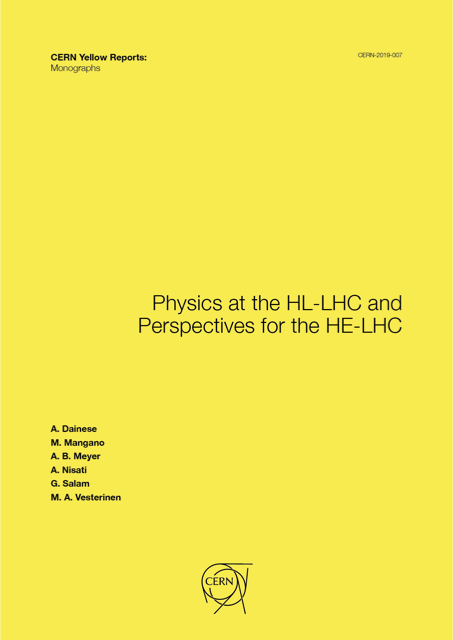
Physics of the HL-LHC, and perspectives at the HE-LHC
Vol. 7 (2019)Editors: A. Dainese, M. Mangano, A. B. Meyer, A. Nisati, G. Salam and M. Vesterinen
This report comprises the outcome of five working groups that have studied the physics potential of the high-luminosity phase of the LHC (HL-LHC) and the perspectives for a possible future high-energy LHC (HE-LHC). The working groups covered a broad range of topics: Standard Model measurements, studies of the properties of the Higgs boson, searches for phenomena beyond the Standard Model, flavor physics of heavy quarks and leptons and studies of QCD matter at high density and temperature.
The work is prepared as an input to the ongoing process of updating the European Strategy for Particle Physics, a process that will be concluded in May 2020.
-

History of the European Muon Collaboration (EMC)
Vol. 5 (2019)Terry Sloan
The European Muon Collaboration (EMC), formed in the years 1972–1974, was one of the first large experimental particle physics collaborations with more than 100 physicists. Its aim was to study the quark structure of the nucleon through deep inelastic muon scattering. Two seminal discoveries were made; the EMC effect and the spin crisis. In this paper the history of the collaboration from beginning to end is described. The appendices describe some of the difficulties met during the development and performance of the experiments as well as a description of some of the social interactions in the collaboration.
-

Study on the career trajectories of people with a working experience at CERN
Vol. 4 (2019)This document describes the results of a study, aiming to measure the impact of CERN and of its environment on the career of people who worked at the laboratory. The data was collected using two on-line question- naires, launched in 2016 and 2017, targeting experimentalists and theorists, respectively. The mandate, the methodology followed, the questionnaires and the analysis of the data collected are presented.
